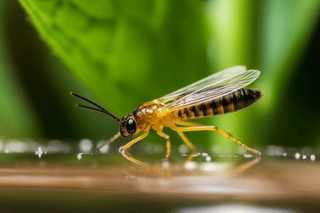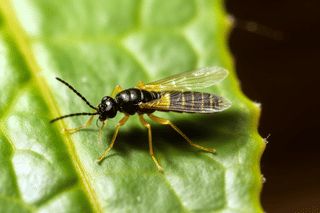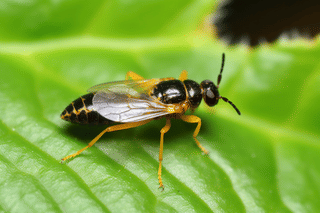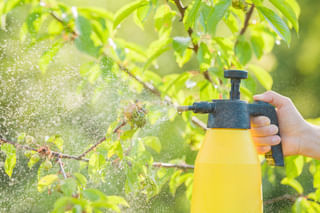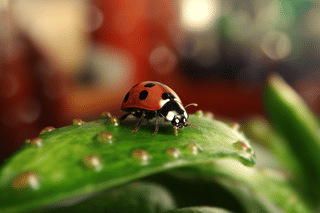How to Get Rid of Thrips on Houseplants
Learn how to get rid of thrips on your houseplants with our easy-to-follow guide. Say goodbye to these small, pesky insects and keep your plants healthy and thriving. Our step-by-step instructions use simple and natural methods that anyone can try. Try our thrip control tips today!
 Are you finding your houseplants under attack by tiny insects? No worries, I'm here to lend a hand! Together, we'll put an end to this invasion and restore peace to your indoor oasis!
Are you finding your houseplants under attack by tiny insects? No worries, I'm here to lend a hand! Together, we'll put an end to this invasion and restore peace to your indoor oasis!
Thrips are a common problem for indoor gardeners and there is hope. In this plant care guide, we'll go over some simple steps you can take to get rid of them from your plants.
With the right tips and some hard work, you can help to keep these insects away from your houseplants without having to resort to chemical treatments or other harsh methods.
These are the topics we're going to look at in this plant care guide:
Don't lose hope in your plant just yet! We're here to dive in and discover how to tackle this problem head-on. Together, we'll find the best solutions and bring your plant back to its healthy, vibrant self!
Remember, every plant faces challenges from time to time, but with a positive mindset and a little know-how, we can overcome them. So, let's roll up our sleeves and embark on this journey of nurturing and reviving your plant!
What are thrips and why are they harmful to houseplants?
Before we can get rid of thrips, we'll need to make sure that we're dealing with thrips and not another pest. Most pests need different methods of getting rid of them, so we'll need to be sure the pest on your plant are thrips.
What do thrips look like?
Thrips are tiny, slender insects that are usually less than a millimeter in length. They can range in color from yellow to brown to black. They have long, narrow wings that fold back over their bodies and they usually have two tiny antennae. Thrips can be difficult to see with the naked eye, so you'll want to use a magnifying glass or hand lens to look for them.
How do they harm your plant?
Thrips are quite harmful to your plants because they damage and deform the leaves, flowers, and even any fruit by puncturing the surface and sucking up the sap.
So thrips suck the sap from your plant, but they also spread viruses between plants. Once thrips infest a plant, they can quickly multiply and cause widespread damage. This is why it's so important to catch these insects early on and take quick action to remove them from your plant.
How do I identify signs of thrips on my houseplants?
Now you know what thrips are and how they harm your plant. But how do you recognize the signs of a thrips infestation without closely inspecting your plant? Let's find out!
When thrips are feeding on your plan, they leave behind silvery or bronze patches on your plant. These patches are caused by the thrips scraping and puncturing the plant's tissues as they feed.
Besides finding the patches, you might also find a white powdery substance on the leaves of your plant. This substance is a waste product the thrips produce. You might also see tiny black spots on the leaves of your plant. These could be difficult to spot, so might require a magnifier. These black spots are eggs they lay on the leaves.
If you haven't caught this early on and the thrips have spread out on your plant, it could lead to leaf curling and distortion.
What can I do to prevent thrips on my houseplants?
The best way to deal with thrips is to prevent them from getting onto your houseplants. I know this might not be helpful if you're already dealing with an infestation of thrips, but this is important for later as you'll be fully prepared to prevent any future infestations.
When you're buying new plants, make sure to keep them away from your other plants for about 2 weeks after you've brought them home. This will give you enough time to inspect the plant for any pests and prevents any surprise pests from spreading to your other plants.
Another way to prevent thrips on your plants is to regularly wipe your plants off. This not only makes your plants look better and healthier but also gives you the chance to inspect your plants a little more closely.
The last way to keep thrips away from your plants is by taking excellent care of them. Healthy plants are much better at dealing with pests than unhappy plants. If you're looking for specific plant care guides, you can find all my plant care guides in the navigation at the top.
How do I get rid of thrips?
So you're actively dealing with a thrips infestation? Let's help you get rid of them and help your plant(s) thrive again!
To get rid of thrips, you can follow the steps below.
Prune Infested Areas
First, take a close look at your plants. Check if any leaves or flowers look damaged or strange. If you find any like that, those are the places where thrips are hanging out.
Next, get some sharp gardening scissors. Carefully cut off the parts of the plants that have thrips on them. Just be careful not to harm the healthy parts of the plants while doing this.
Here's something important to remember: after you remove the thrips-infested parts, you need to dispose of them properly. Thrips can crawl out of places like compost heaps or garbage cans. So, put the plant parts you cut off in a strong bag or container and seal them tightly. This will prevent the thrips from coming back.
Wash the Plant
Once you're done pruning, it's a good idea to wash your plant's leaves with a mixture of water and dish soap. This can help get rid of any thrips or eggs that might still be on the plant. Remember to use a mild and safe soap, and make sure to rinse the plant completely after washing.
Here's how to do it:
- Prepare a mixture of water and gentle dish soap.
- Carefully wet the leaves of your plant with the soapy water.
- Gently rub the leaves with your fingers or a soft cloth to remove any remaining thrips or eggs.
- Afterward, thoroughly rinse the plant with clean water to wash away the soap and any remaining pests.
- Allow the plant to air dry or gently pat it dry with a clean towel.
By following these steps, you'll be helping your plant stay free from thrips and their eggs.
Kill Thrips with Bug Spray
Another choice you have is to use insecticidal soap or neem oil spray. These products can suffocate the thrips and help eliminate them.
Here are some important things to remember when using these sprays:
- Read and follow the instructions on the label carefully.
- Wear gloves and eye protection while applying the spray to protect yourself.
- Only use insecticidal soap or neem oil that is specifically made for plants.
- Avoid using bug sprays that are not meant for houseplants. They may harm your plants or not work effectively against thrips.
By using insecticidal soap or neem oil spray correctly, you can combat thrips and keep your plants healthy.
Use Sticky Traps
Another effective method to deal with thrips is by using sticky traps. These traps are placed near your plants and attract the insects towards them. Once the thrips come close, they get stuck in the traps. This can help decrease the number of thrips on your plants.
Here's how you can use sticky traps:
- Get some sticky traps specifically designed for catching insects. You can find them at garden stores or online.
- Place the traps near your plants, making sure they are within the thrips' reach.
- The traps will have a sticky surface that attracts and captures the thrips when they land on it.
- Periodically check the traps and replace them when they become full or lose their stickiness.
By using sticky traps, you can effectively reduce the population of thrips and protect your plants.
Introduce Beneficial Insects
Lastly, you can think about bringing helpful insects into your home, such as ladybugs or lacewings. These insects are beneficial because they eat thrips and can assist in keeping the pest population in check.
Here's how you can introduce beneficial insects:
- Purchase ladybugs or lacewings from a garden store or online.
- Release the insects near your plants during the evening when it's cooler, as they tend to be more active at that time.
- Allow the insects to explore and find the thrips-infested areas.
- Ladybugs and lacewings will naturally feed on thrips, reducing their numbers over time.
By introducing beneficial insects like ladybugs or lacewings, you can have natural allies that help control thrips and protect your plants.
Conclusion
Thrips can be a serious problem for houseplants, but with these tips, you can take action to get rid of them. Remember to regularly inspect your plants and quarantine new plants, to prevent thrips and other pests from becoming a problem. And if you do find that your plants are infested with thrips, prune the infested areas, wash the plant, use bug spray, use sticky traps, or introduce beneficial insects to help control the population of thrips.
Thank you for reading this post! I hope it helps you to keep your plants healthy and beautiful! If you're looking for more guides on specific plants, you can always request a plant guide to get a guide for the plant you have trouble with.
Test your plant care knowledge
Quiz completed!
Want to learn more? Sign up for my newsletter to receive free tips in your inbox!
Sign up now!